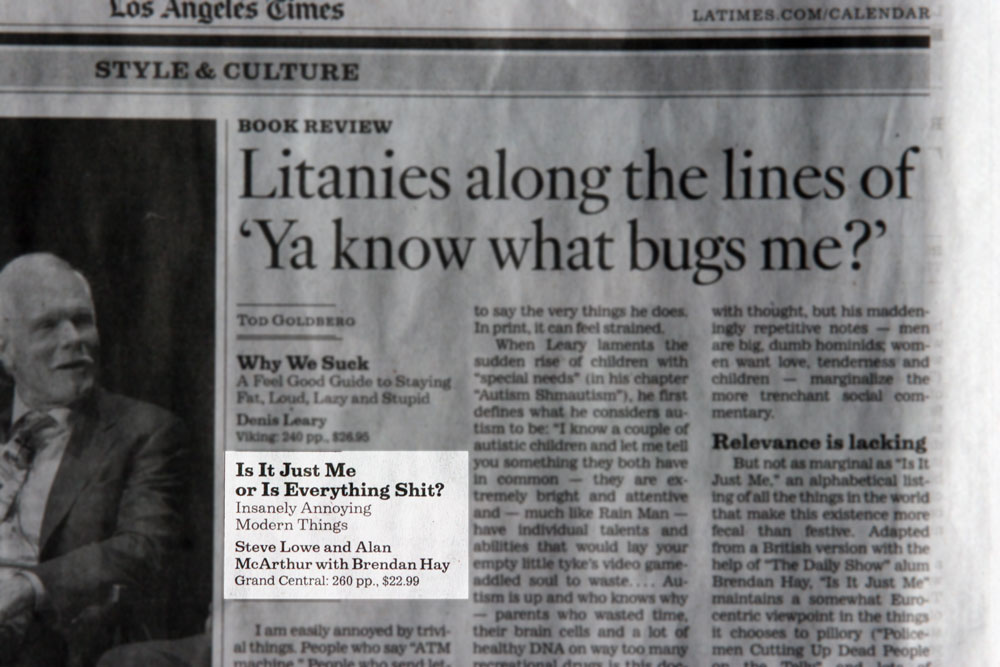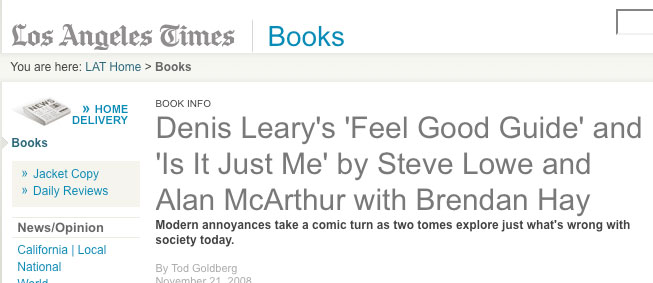This came in through the comment threads, and is thoughtful enough that it merits more attention:
It sounds like both media channels worked as I would expect them too. The mainstream media sticks with the low risk stories that are easy to substantiate and defend while New Media takes risks on radical story ideas, digest the story in the public forum, shares the discoveries with its readers and lets the readers decide when it is time to move on to other issues.
Very true, and a very good observation. However – my worry is that as the mainstream media increasingly dissolves, their filters grow ever weaker. Evidence of this can be seen in the big bounce in the amount of glaring errors in print editions – this last week, I noted big, bad spelling errors on the front page of the LA Times. The jump pages aren’t where they’re supposed to be. The same paragraph gets printed twice.

Apparently, the editorial guidlines have changed at the LA Times... or, to put it more colloquially, "the shit has loosened up."
Basically, the cuts in editorial positions have left the papers so stressed that they are vulnerable to the kinds of errors that would previously have been unthinkable. And if papers can screw up on something so simple as whether or not the word “Shit” should be put in a headline for a book review (as it was today), then a complex story that demands that reporters and editors pay close attention and follow a thread to its logical conclusion – well, that capability may not longer be in the traditional newsroom.
I have hopes (perhaps naive & unwarranted) that there will be a disaggregated Newsroom of the Future, where reporters and The People Formerly Known As The Audience all work together to separate truth from spin. The Look&Feel of this Newsroom of the Future is being chiseled out of the raw WebChaos on sites like TPM, Firedoglake, ProPublica, Publish2, RedState, and even on Michelle Malkin (hey – she called the “B on the face” girl out as a fraud).
It looks kinda like the same model that’s been in existence for hundreds (maybe even thousands) of years:
- The reporter/blogger/town crier/social media collective identifies a trend or event as significant, and communicates that to the people in their circle of influence (make up a term – audience, listeners, readers, lurkers, etc.)
- Those people take in that message and react. In the traditional media models, a positive reaction would be to buy more papers, tell their friends to tune in to the next newscast, and discuss it around the watercooler.
- Positive feedback means the originator keeps doing more – that is, follow-up stories, sidebars, looking for more stories like that.
- In the online world, positive feedback can mean that the audience self-deputizes and starts haring off on their own, trying to add their efforts to expand the narrative.
- Negative feedback – the audience not caring about or responding to the story – means that the reporter/blogger/town crier moves on to the next story
The only change is that the web makes all this happen much faster, and allows the audience to get much more involved than was possible before.
And yeah, I know, this kind of thinking is hardly original. But we’re seeing the dissolution of the traditional media happen much quicker than we had anticipated. And yeah, I’m aware that history is replete with examples of traditional media being used to perpetrate Big Lies & Big Mistakes – from the Spanish-American War of 1898, waged because newspaper publisher William Randolph Hearst wanted a cause to boost circulation (where we get the famous quote “You furnish the pictures and I’ll furnish the war”) to the yellowcake uranium and 18 words in the State of the Union address.
The point is, that as it is now easier for smaller & less powerful groups to take on the mantle of the MSM, it is also increasingly possible for smaller & less powerful groups to drill into the national narrative for their own purposes…
I’ll leave you with this, from the Hearst link above:
Hearst upped his circulation by producing a new kind of paper, one with mass- market appeal. His papers used lots of pictures and illustrations, large headlines, and the like. Reducing the cost of a paper to as little as a single cent a copy, Hearst made his newspapers accessible to nearly everyone. Because he controlled so much of the market for newspapers, a market that was rapidly growing because of his newspapers, Hearst could practically dictate what the country would think the next day.
The whole point of yellow journalism was to produce exciting, sensational stories, even if the truth had to be stretched or a story had to be made up. These stories would boost sales, something very important in this period, when newspapers and magazines were battling for circulation numbers. In regard to the situation in Cuba in the mid-1890s, yellow journalism sought to exploit the atrocities in Cuba to sell more magazines and newspapers.The papers depicted Spanish behavior as exaggeratedly bad, and political cartoons depicted “Spain” as a nearly subhuman and brutal monster, while “Cuba” was usually depicted as a pretty white girl being pushed around by the Spanish monster. Once US opinions were inflamed over Cuba, Hearst in particular tried to do everything he could to whip the public into such a frenzy that a war would start. Once the country was at war, Hearst had little doubt his papers would have no end of interesting and sensational articles to publish.


Meanwhile, the dead-enders are still screaming for a full investigation of Obama’s supposed Kenyan birth certificate, claiming to have eyewitnesses to Obama’s birth in Kenya… http://www.topix.com/forum/us/TU59DOBBR3907N41J
The tinfoil hat crowd has seized on this, and will not let it go.